William Bloye
William James Bloye ARBSA (8 July 1890 – 6 June 1975) was a British sculptor, active in Birmingham either side of World War II.
William Bloye | |
|---|---|
| Born | William James Bloye 8 July 1890[1] Birmingham, England |
| Died | 6 June 1975 (aged 84) Arezzo, Italy |
| Known for | Sculpture |
| Awards |
|
Life
Bloye studied, and later, taught at the Birmingham School of Art (his training was interrupted by World War I, when he served in the Royal Army Medical Corps from 1915 to 1917;[2] he was eventually succeeded at Birmingham by John Bridgeman), where his pupils included Gordon Herickx, Roy Kitchin, Raymond Mason, John Poole and Ian Walters. He also studied stone-carving and letter cutting under Eric Gill around 1921.

In 1925 Bloye became a member of the Birmingham Civic Society, having, at about that time, a studio at 111, Golden Hillock Road, Small Heath, Birmingham. As Birmingham's unofficial civic sculptor he worked on virtually all public commissions including libraries, hospitals and the University. He often carved bas-relief plaques, typically for public houses in Birmingham, and decorated a number of buildings by the architect Holland W. Hobbiss. During the 1920s, he served on the Technical Committee of the Birmingham Civic Society.[3]
Bloye became a member of the Royal British Society of Sculptors: associate (with the honorific suffix ARBS) in 1934, and fellow (FRBS) in 1938. He also won the latter's Otto Beit Medal. Retiring from the School of Art in 1956 he moved to Solihull. He died in Arezzo, Italy in 1975.
In December 2010, a blue plaque was unveiled at City College, on the site of his former studio.[2]
As of January 2010, Birmingham City Council are working on the restoration of Bloye's statue of Pan at Aston Hall. The statue's head is missing, and they have appealed for old photographs to assist in its reconstruction.[4]
RBSA

Bloye was closely associated with the Royal Birmingham Society of Artists (RBSA). Although the two 1919 bronze plaques at the RBSA entrance are the earliest known work by Bloye in Birmingham, he became a member only in 1930.[5] After a period as vice-president, he became president in 1948[6] and served in that role until 1950. He was also the RBSA's Professor of Sculpture[6] from at least the mid-1940s until at least 1961[7] (after which time the post is no longer mentioned in the annual catalogues).[8]
The Society's permanent collection includes one of his works, a life-size plaster bust, Head of Man.[9] It is undated and not usually on display. The subject's name is not recorded.
Selected public works
1919
| Image | Title / subject | Location and coordinates |
Date | Type | Material | Dimensions | Designation | Owner / administrator | Notes |
|---|---|---|---|---|---|---|---|---|---|
 |
Allegories of Art and Industry | Above north-west door of Birmingham Museum & Art Gallery (The Feeney Gallery extension), Great Charles Street 52.4811°N 1.9050°W |
c. 1919 | Stone | Birmingham City Council | [10] | |||
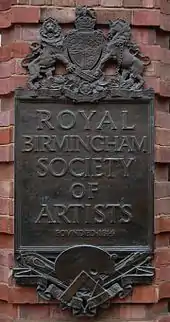 |
Bronze Plaques | Royal Birmingham Society of Artists 52.484891°N 1.907520°W |
1919 | Bronze | Formerly at the Society's old headquarters on New Street[10] |
1920-1929
| Image | Title / subject | Location and coordinates |
Date | Type | Material | Dimensions | Designation | Owner / administrator | Notes |
|---|---|---|---|---|---|---|---|---|---|
 More images |
Lion Pediment and Seated Craftsmen | Supreme Works, 186 Soho Hill, Handsworth 52.50018°N 1.92123°W |
1922 | Bas-relief | Stone | [10] | |||
 |
Maternity | Carnegie Welfare Institute, Hunter's Road, Hockley 52.49712°N 1.91522°W |
c.1923-6 | Painted mahogany | [10] | ||||
 |
Call, Front Line and Return | Hall of Memory, Broad Street 52.4795°N 1.9070°W |
1925 | Interior bas-relief carvings | [10] | ||||
 More images |
Sun and lettering | Sun Insurance Building, Bennetts Hill 52.47991°N 1.90025°W |
1927 | Bas-relief | Stone | [10] | |||
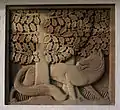 |
Fox and Hollybush | Acocks Green 52.44408°N 1.83418°W |
1927-8 | Bas-relief | From former Fox Hollies pub.[10] Now on Lidl supermarket. | ||||
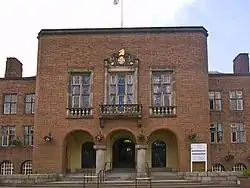 |
Coat of arms and two lion reliefs | Council House, Priory Road, Dudley 52.5122°N 2.0841°W |
1928 | Façade on Council House[11] | |||||
 |
War Memorial: George and the Dragon and lions on flagpoles | Town Hall, Priory Street, Dudley 52.5115°N 2.0844°W |
1928 | Also four bronze lions (1936) on flagpoles, Town Hall tower[11] | |||||
 |
Running stag | Perry Barr Stadium 52.519192°N 1.897717°W |
1929 | Bas-relief | Stone | Logo of Birchfield Harriers. Attributed.[10] | |||
 |
The Antelope | Sparkhill 52.453362°N 1.865753°W |
c. 1929 | Bas-relief pub sign | Designed by Bloye, sculpted by his assistant, Tom Wright[10] | ||||
| Allegory of Painting | Former Art Gallery, Avenue Road, Leamington Spa | 1929 | Sandstone | Life-size female nude[12] |
1930-1940
| Image | Title / subject | Location and coordinates |
Date | Type | Material | Dimensions | Designation | Owner / administrator | Notes |
|---|---|---|---|---|---|---|---|---|---|
 |
Aesculapius | Chest Clinic, Great Charles Street 52.4817°N 1.9047°W |
1930 | Relief carving | Stone | [10] | |||
 More images |
Wisdom, Fortitude, Charity, Faith | Legal and General Assurance Building, 7 Waterloo Street 52.480405°N 1.900024°W |
1932 | Four bas relief panels | Exterior high level bas-relief carvings.[10] | ||||
 |
Sermon to the Birds | St Francis of Assisi's Church, Bournville 52.42902°N 1.93558°W |
1933 | Oak | Part of Grade II listed building.[10] | ||||
.jpg.webp) |
Pan | Aston Hall, Birmingham 52.50658°N 1.88577°W |
1934 | [4][10] | |||||
 |
Two stone vases | Aston Hall, Birmingham 52.50666°N 1.88519°W 52.50642°N 1.88524°W |
1934 | Vases | Stone | Birmingham City Council | [10] | ||
 More images |
Lamp of Knowledge | Perry Common Library 52.535590°N 1.875583°W |
c. 1934 | Bas-relief | stone | [10] | |||
 |
Brookvale Pub | Erdington 52.51399°N 1.85737°W |
1934 | Pub sign with putto and grapes | Painted stone | [10] | |||
 |
Capitals and Heads | Council House, Priory Road, Dudley 52.5122°N 2.0841°W |
1935 | [11] | |||||
| Dudley from the Wren's Nest | Council House, Priory Road, Dudley 52.5121°N 2.0844°W |
1935 | Two reliefs | Plaster | Within building – at entrance to council chamber and entrance to committee reception room.[11] | ||||
 More images |
Capitals and pediment sculptures | New Oxford House, 16 Waterloo Street 52.479942°N 1.901489°W |
1935 | Exterior: two capitals, shield above door and upstairs pediment and putto.[10] | |||||
 |
Dudley's Past | Town Hall, corner of Priory Road and Priory Street, Dudley 52.5120°N 2.0839°W |
1935 | [11] | |||||
 |
Mother and Child, Young Child Playing | 90 Lancaster Street, Birmingham 52.48731°N 1.89370°W |
c.1935 | Bas-relief | Stone | [10] | |||
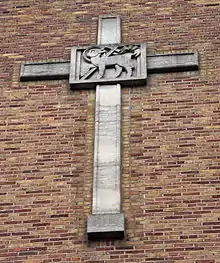 |
The Good Shepherd and Latin Cross | Christ Church, Ward End 52.48984°N 1.82130°W |
c.1935 | Bas-relief | Stone | [10] | |||
.jpg.webp) |
Royal Oak | Lozells 52.502687°N 1.900501°W |
c.1936 | Stone | Decoration around the doorway of a former pub (now a shop). Formerly brightly painted.[10] | ||||
 |
The Towers | Tower Hill, Great Barr 52.535574°N 1.92062°W |
1936 | Stone | Bloye was responsible for all the stone carving on this brick building[10] | ||||
| St. Nicholas Rescuing the Three Children | John Shelton School, Coventry (former) | 1936 | Lost after the school was demolished in 1999[12] | ||||||
 More images |
Spirit of Knowledge | Yardley Wood Library 52.41856°N 1.85970°W |
c.1936 | Bas-relief | stone | [10] | |||
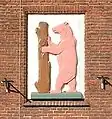 |
Bear and Staff | The Bear Inn, Stratford Road, Sparkhill 52.448235°N 1.861201°W |
c.1937 | Bas-relief | Pub sign, depicting symbol of Warwickshire, in which the area was located at the time of installation.[10] | ||||
 |
The Boar's Head | The Boar's Head, Perry Barr 52.529153°N 1.895465°W |
c. 1938 | Wood | Painted pub sign with model of a boar's head, on a pole.[10] Taken from the arms of the Gough-Calthorpe family of nearby Perry Hall | ||||
 |
Library Emblem | Yardley Library, Yardley 52.461°N 1.816°W |
1938 | ||||||
 |
Aesculapius | Medical School, University of Birmingham 52.45190°N 1.93813°W |
c.1938 | [10] | |||||
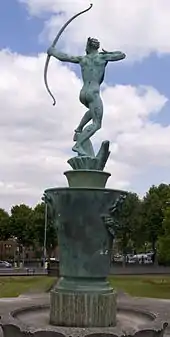 |
Apollo fountain | Coronation Gardens, Ednam Road, Dudley 52.51277°N 2.08337°W |
1939 | Sculpture on top of fountain | [11] The model was international gymnast and basketball player Fred Starkey.[13] The plaster models are in the collection of Birmingham Museums Trust.[14] | ||||
 |
Huntsman and Dog | The Green Man Pub, High Street, Harborne 52.46138°N 1.94301°W |
c.1940 | Pub sign | Painted wood | [10] |
1950-1959
| Image | Title / subject | Location and coordinates |
Date | Type | Material | Dimensions | Designation | Owner / administrator | Notes |
|---|---|---|---|---|---|---|---|---|---|
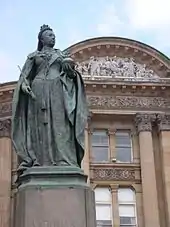 More images |
Queen Victoria | Victoria Square 52.479628°N 1.902998°W |
1951 | Statue on pedestal | Bronze and stone | Birmingham City Council | Recast from a 1901 marble statue by Thomas Brock[10][15] | ||
 |
Christ | All Saints' Church, Shard End 52.49454°N 1.77601°W |
1951–5 | Statue in niche | Stone | [10] | |||
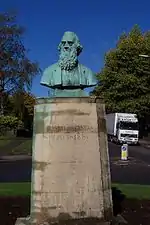 More images |
Josiah Mason | Junction of Chester Road & Orphanage Road, Erdington 52.531556°N 1.825128°W |
1952 | Bust on plinth | Bronze | Cast from a 1885 marble statue (subsequently destroyed) by Francis John Williamson, which stood opposite Mason Science College in Edmund Street[10] | |||
| Engineering | Mechanical Engineering Building, University of Birmingham 52.44928°N 1.93509°W |
1954 | Bas-relief | [10] | |||||
 More images |
Boulton, Watt and Murdoch | Broad Street 52.478587°N 1.908395°W |
1956 | Three statues on plinth | Gilded bronze | Birmingham City Council | Matthew Boulton, James Watt and William Murdoch[15] | ||
 |
John Skirrow Wright | Birmingham Council House 52.480082°N 1.902760°W |
1956 | Bust | Bronze | Cast from a marble statue (subsequently destroyed) by Francis John Williamson[10] | |||
 |
St. Alphege | St. Alphege CofE Infants School, New Road, Solihull 52.41148°N 1.77450°W |
1959 | Restored in 1994[12] |
1960-1974
| Image | Title / subject | Location and coordinates |
Date | Type | Material | Dimensions | Designation | Owner / administrator | Notes |
|---|---|---|---|---|---|---|---|---|---|
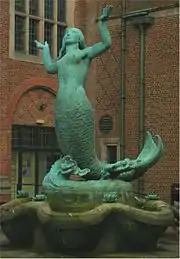 |
Mermaid fountain | University of Birmingham Guild of Students 52.44927°N 1.927225°W |
1960 | Fountain | Bronze | [10] | |||
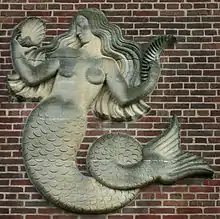 |
Mermaid | University of Birmingham Guild of Students 52.44951°N 1.92741°W |
1960 | Wall mounted sculpture | Stone | [10] | |||
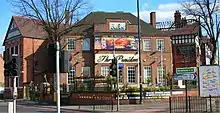 |
Decoration | The Mermaid (public house), Sparkhill 52.456861°N 1.868761°W |
c.1960 | Bas-relief pub sign attributed to Alan Bridgewater[10] | |||||
 |
Ceres - Goddess of Corn | CB1, Mill Park, Cambridge | 1962 | Sculpture | Bronze and concrete | [16] | |||
| Wilfred Byng Kenrick | Byng Kenrick Grammar School For Girls | 1962, unveiled 1963 | Bust | Bronze | Lost, believed stolen.[10] | ||||
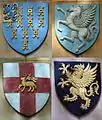 More images |
Heraldic sculptures | Fountain Court, Steelhouse Lane 52.48370°N 1.89494°W |
1964 | Bas-reliefs | Stone | A bronze statue of a girl in a fountain in a private courtyard at the same location is by Bloye.[10] | |||
 |
Coat of Arms | Birmingham Dental Hospital 52.485875°N 1.895101°W |
c.1973 | Fibreglass | Now removed.[10] |
Date unknown
| Image | Title / subject | Location and coordinates |
Date | Type | Material | Dimensions | Designation | Owner / administrator | Notes |
|---|---|---|---|---|---|---|---|---|---|
 |
Head of Man | Royal Birmingham Society of Artists | Plaster | [9] | |||||
 More images |
Ten ceiling panels | Old Assembly Hall, Moseley School 52.44066°N 1.86433°W |
[17] |
References
| Wikimedia Commons has media related to William Bloye. |
- "William James Bloye ARBS". Mapping the Practice and Profession of Sculpture in Britain and Ireland 1851–1951. University of Glasgow History of Art. Retrieved 17 July 2017.
- "Life of Birmingham sculptor William Bloye commemorated". City College. December 2010. Archived from the original on 21 July 2011. Retrieved 11 December 2010.
- "Ornamental Fountain". National Recording Project. Public Monument and Sculpture Association. Retrieved 28 October 2010.
- "The mystery of the headless statue". Birmingham Newsroom. Birmingham City Council. 17 January 2011. Retrieved 17 January 2011.
- Anon (1930). "The Spring Exhibition, 1930 (catalogue)". RBSA. Cite journal requires
|journal=(help) - Anon (1948). "Royal Birmingham Society of Artists Autumn Exhibition 1948 (catalogue)". RBSA. Cite journal requires
|journal=(help) - Anon (1961). "The Second Spring Exhibition, 1961 (catalogue)". RBSA. Cite journal requires
|journal=(help) - RBSA catalogues, 1962 onwards
- RBSA archives, catalogue number B43
- Noszlopy, George T. (1998). Public Sculpture of Birmingham including Sutton Coldfield. Public Sculpture of Britain. 2. Liverpool University Press. ISBN 0-85323-682-8.
- Noszlopy, George T. (2005). Public Sculpture of Staffordshire and the Black Country. Public Sculpture of Britain. 9. Liverpool University Press. ISBN 978-0-85323-999-4.
- Noszlopy, George T. (2003). Public Sculpture of Warwickshire, Coventry and Solihull. Public Sculpture of Britain. 6. Liverpool University Press. ISBN 0-85323-847-2.
- Anon (2 April 2001). "Former city man tribute". Birmingham Evening Mail. Archived from the original on 29 March 2015. – via HighBeam Research, subscription needed
- Accession numbers: 1991P111; 1991P112
- A User's Guide to Public Sculpture. English Heritage / PMSA. 2000. ISBN 185074776 8.
- "Trail 1 - South Cambridge". Cambridge Sculpture Trails. Retrieved 18 August 2020.
- The Moseleians Association – Moseley School and the work of William Bloye (1890–1975)